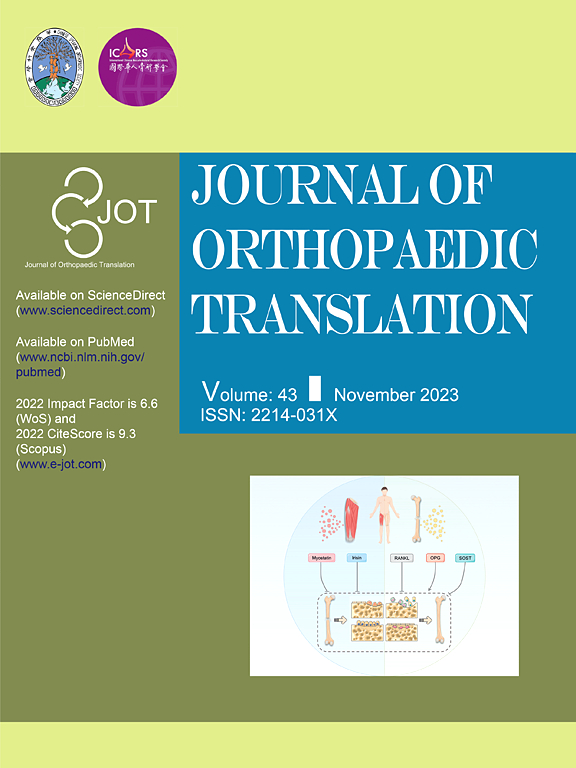Fibroblast growth factor receptor 3 mutation promotes HSPB6-mediated cuproptosis in hypochondroplasia by impairing chondrocyte autophagy
IF 5.9
1区 医学
Q1 ORTHOPEDICS
引用次数: 0
Abstract
Background
Hypochondroplasia (HCH) is a prevalent form of dwarfism linked to mutations in the fibroblast growth factor receptor 3 (FGFR3) gene, causing missense alterations. We previous report was the first to identify FGFR3(G382D) gain-of-function variants with a positive family history as a novel cause of HCH. However, the precise contribution of FGFR3 to the pathogenesis of HCH remains elusive.
Methods
We generated an Fgfr3 (V376D) mutation mouse model using CRISPR/Cas9 technology and performed proteomic analyses to investigate the molecular mechanisms and potential therapeutic targets of HCH. Radiography and micro-computed tomography were employed to assess the bone-specific phenotype in Fgfr3 (V376D)mutant mice. Immunofluorescence, western blotting, and flow cytometry were used to systematically investigate the underlying mechanisms and therapeutic targets.
Results
We observed that Fgfr3 (V376D) mutant mice exhibit a bone-specific phenotype, with symmetrically short limb bones, partially resembling the dwarfism phenotype of patients with HCH. We demonstrated that the mutant-activated FGFR3 promotes heat shock protein B 6 (HSPB6)-mediated cuproptosis by inhibiting chondrocyte autophagy both in vivo and in vitro. Additionally, we revealed that FGFR3 (G382D) mutation leads to enhanced ERK signaling, increased Drp1-mediated mitochondrial fission, and upregulated cuproptosis-related protein ferredoxin 1 (FDX1). Furthermore, genetic and pharmacological inhibition of the HSPB6-ERK-Drp1-FDX1 pathway partially alleviate the phenotypes of FGFR3 mutants.
Conclusions
Our study provides the first evidence for the pathogenicity of a gain-of-function mutation in FGFR3 (G382D) using mouse and cell models, and it underscores the potential of targeting the HSPB6-ERK-Drp1-FDX1 axis as a novel therapeutic approach for HCH.
Translational potential of this article
We first demonstrate that impaired autophagy and enhanced cuproptosis are pivotal in the pathogenesis of HCH. This study not only enlarged the therapeutic potential of targeting cuproptosis for treating FGFR3 mutation-related HCH but also provided a novel perspective on the role of the HSPB6-ERK-Drp1-FDX1 signaling pathway in the development of HCH. Consequently, this article provides valuable insights into the mechanisms and treatment strategies for FGFR3 mutation-related chondrodysplasia.

成纤维细胞生长因子受体3突变通过损害软骨细胞自噬促进hspb6介导的软骨发育不全中的铜增生
软骨发育不全(HCH)是一种常见的侏儒症,与成纤维细胞生长因子受体3 (FGFR3)基因突变有关,导致错义改变。我们之前的报告首次确定了具有阳性家族史的FGFR3(G382D)功能获得变异是HCH的新病因。然而,FGFR3在HCH发病机制中的确切作用仍然难以捉摸。方法利用CRISPR/Cas9技术建立Fgfr3 (V376D)突变小鼠模型,进行蛋白质组学分析,探讨HCH的分子机制和潜在的治疗靶点。采用x线摄影和显微计算机断层扫描来评估Fgfr3 (V376D)突变小鼠的骨特异性表型。利用免疫荧光、免疫印迹和流式细胞术系统地研究其潜在机制和治疗靶点。结果我们观察到Fgfr3 (V376D)突变小鼠表现出骨特异性表型,具有对称的短肢骨,部分类似于HCH患者的侏儒症表型。我们证明了突变激活的FGFR3通过抑制体内和体外的软骨细胞自噬来促进热休克蛋白b6 (HSPB6)介导的铜增生。此外,我们发现FGFR3 (G382D)突变导致ERK信号增强,drp1介导的线粒体分裂增加,铜胞分裂相关蛋白铁氧还蛋白1 (FDX1)上调。此外,HSPB6-ERK-Drp1-FDX1通路的遗传和药理学抑制部分减轻了FGFR3突变体的表型。通过小鼠和细胞模型,我们的研究首次证明了FGFR3 (G382D)功能获得性突变的致病性,并强调了靶向HSPB6-ERK-Drp1-FDX1轴作为HCH治疗新方法的潜力。我们首先证明自噬受损和铜增生增强在HCH的发病机制中是关键的。本研究不仅扩大了靶向cuprotosis治疗FGFR3突变相关HCH的治疗潜力,而且为HSPB6-ERK-Drp1-FDX1信号通路在HCH发展中的作用提供了新的视角。因此,本文为FGFR3突变相关软骨发育不良的机制和治疗策略提供了有价值的见解。
本文章由计算机程序翻译,如有差异,请以英文原文为准。
求助全文
约1分钟内获得全文
求助全文
来源期刊

Journal of Orthopaedic Translation
Medicine-Orthopedics and Sports Medicine
CiteScore
11.80
自引率
13.60%
发文量
91
审稿时长
29 days
期刊介绍:
The Journal of Orthopaedic Translation (JOT) is the official peer-reviewed, open access journal of the Chinese Speaking Orthopaedic Society (CSOS) and the International Chinese Musculoskeletal Research Society (ICMRS). It is published quarterly, in January, April, July and October, by Elsevier.
 求助内容:
求助内容: 应助结果提醒方式:
应助结果提醒方式:


